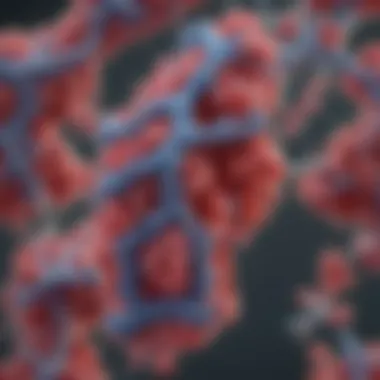Understanding IgM Kappa Monoclonal Gammopathy


Intro
IgM kappa monoclonal gammopathy represents a unique clinical condition often encountered in hematology and oncology. This condition arises when a single clone of B lymphocytes produces an abnormal quantity of immunoglobulin M (IgM) that contains kappa light chains. The pathogenesis of this disorder is intricate and reflects broader mechanisms involved in immunological response and disease progression.
This article focuses on a thorough exploration of IgM kappa monoclonal gammopathy. It aims to dissect the clinical ramifications, diagnostic methodologies, and existing treatment strategies.
Research Overview
Summary of Key Findings
Understanding IgM kappa monoclonal gammopathy is crucial for effective patient management. Recent studies indicate that patients may experience a range of symptoms, from asymptomatic cases to serious conditions like Waldenström macroglobulinemia. Key findings suggest that laboratory assays, including serum protein electrophoresis and immunofixation, are essential for diagnosis.
Background and Context
The history of monoclonal gammopathy dates back to the mid-20th century. Early researchers established the foundational understanding of immunoglobulin classes, including their roles in immune defense. However, the specifics of IgM kappa monoclonal gammopathy have evolved.
Clinicians often face challenges in differentiating between benign and malignant forms of this disorder. Growing evidence supports the need for a multi-faceted approach to diagnosis and management. The complexity arises partly from the diverse presentations of patients, necessitating heightened awareness among healthcare professionals.
Methodology
Experimental Design
In recent research studies, various methodologies have been used to investigate the nature of IgM kappa monoclonal gammopathy. Some studies employed cohort designs, examining patient demographics, clinical features, and laboratory findings. Longitudinal studies have also been utilized to track disease progression over time.
Data Collection Techniques
Data is typically collected through systematic patient evaluations, including:
- Clinical assessments: Documentation of symptoms and medical history.
- Laboratory tests: Measurement of serum immunoglobulin levels and bone marrow biopsies.
- Imaging studies: Utilization of radiography or MRI to evaluate disease extent.
These techniques allow for a comprehensive understanding of disease characteristics and guide treatment decisions.
Engaging with the latest research and insights on IgM kappa monoclonal gammopathy equips medical professionals with necessary knowledge for improved patient outcomes.
Prologue to Monoclonal Gammopathies
Monoclonal gammopathies represent a group of disorders characterized by the proliferation of a single clone of plasma cells that produce a monoclonal immunoglobulin. Understanding monoclonal gammopathies is crucial as they can indicate underlying malignancies, particularly multiple myeloma, or other related diseases.
Knowledge of these conditions allows medical professionals to make informed decisions regarding diagnosis, management, and treatment strategies. This is particularly important in distinguishing benign from malignant forms, where early intervention can significantly impact patient outcomes.
Definition and Classification of Monoclonal Gammopathies
Monoclonal gammopathies can be broadly classified into two categories: benign and malignant. The benign form typically refers to monoclonal gammopathy of undetermined significance (MGUS), which is distinguished by low levels of monoclonal proteins and a low risk of progression to more severe disease. In contrast, malignant forms include multiple myeloma, Waldenström macroglobulinemia, and primary amyloidosis, each associated with significant clinical implications.
Diagnosis involves various laboratory tests to identify and quantify the monoclonal proteins, most often through serum protein electrophoresis. This helps establish baseline levels for monitoring progression or response to treatment.
Overview of Immunoglobulins
Immunoglobulins, also known as antibodies, are crucial components of the immune system. They are produced by B cells and play a pivotal role in identifying and neutralizing pathogens. There are five main classes of immunoglobulins: IgA, IgD, IgE, IgG, and IgM, each with distinct functions within the immune response.
In the context of monoclonal gammopathies, IgM kappa monoclonal gammopathy specifically involves the overproduction of the IgM antibody type. This most often arises from a single clone of plasma cells that exclusively produces IgM with kappa light chains. Understanding the variations in immunoglobulin production is essential in diagnosing and managing monoclonal gammopathies.
"Identifying monoclonal gammopathies early can significantly improve the course of treatment and patient management."
The interplay between different immunoglobulins impacts how the immune system functions and its ability to respond to infections. Disruptions in normal immunoglobulin production can lead to complications, contributing to the clinical significance of monoclonal gammopathies.
In summary, understanding the definitions and classifications of monoclonal gammopathies, along with a comprehensive overview of immunoglobulins, lays the groundwork for exploring more complex aspects, such as the characteristics and clinical implications of IgM kappa monoclonal gammopathy. This foundational knowledge is critical for medical professionals, researchers, and students aiming to navigate the complexities of these disorders.
Exploring IgM Kappa Monoclonal Gammopathy
The examination of IgM kappa monoclonal gammopathy is of significant importance in both clinical and research settings. This condition represents a specific subset of monoclonal gammopathies, characterized by the presence of abnormal IgM antibodies produced by a clone of B cells. Understanding this type of gammopathy allows medical professionals to identify proper diagnostic criteria and target treatment strategies effectively, thus influencing patient outcomes.


Key Considerations:
- Clinical Significance: Recognizing IgM kappa monoclonal gammopathy ensures that healthcare providers can differentiate it from other disorders, such as multiple myeloma or chronic lymphocytic leukemia.
- Diagnostic Processes: The specifics of this condition call for a tailored approach in diagnosis, which includes serum protein electrophoresis and immunofixation studies to confirm monoclonality.
- Patient Management: Insight into the characteristics of IgM kappa monoclonal gammopathy aids in creating effective long-term management plans, focusing on both disease progression and symptomatic relief.
Characteristics of IgM Kappa Monoclonal Gammopathy
IgM kappa monoclonal gammopathy has distinct characteristics that set it apart from other gammopathies. The predominant feature is the elevation of IgM immunoglobulin levels, which may result in a range of clinical manifestations. Patients can present with hyperviscosity related symptoms, such as headaches, dizziness, or visual disturbances.
Clinical Features Include:
- Elevated IgM Levels: Confirmatory lab tests often reveal increased IgM, generally above 1,000 mg/dL, which is indicative of monoclonal production.
- B Cell Clone Identification: Identifying the kappa light chain dominance provides insight into the specific origin of the gammopathy.
- Potential Complications: A notable rise in Mona to IgM levels may lead to additional complications, such as peripheral neuropathy or hematological concerns.
The clinical assessment of patients may include a thorough health history and physical examination to recognize these features early.
Incidence and Prevalence
The epidemiology of IgM kappa monoclonal gammopathy reveals important insights into its incidence and prevalence rates. Current estimates suggest that the overall prevalence is relatively low compared to other forms of gammopathy, yet significant among specific populations.
Incidence Information:
- Age Factor: The onset typically occurs in older adults, predominantly those aged 60 and above.
- Sex Distribution: Males appear to be slightly more affected than females, indicating a potential influence of biological factors.
- Geographical Variability: There are observed differences in prevalence based on geographical location, which may stem from genetic, environmental, or lifestyle factors.
Statistics and Studies:
- According to studies, IgM kappa monoclonal gammopathy constitutes approximately 1-2% of all monoclonal gammopathy cases. Some reports reflect higher percentages among certain high-risk populations.
- Ongoing research is essential to better understand the demographic trends and risk factors associated with this condition.
Understanding the epidemiological dynamics of IgM kappa monoclonal gammopathy contributes to public health strategies aimed at early diagnosis and intervention.
Pathophysiology of IgM Kappa Monoclonal Gammopathy
The pathophysiology of IgM Kappa Monoclonal Gammopathy is critical for understanding the disease's progression and clinical implications. This section will delineate the processes involved in B-cell development and the mechanisms behind monoclonal expansion. Grasping these concepts can provide insights into potential therapeutic targets and inform clinical management strategies.
B-Cell Development and Function
B-cells are a type of white blood cell of pivotal importance in the immune system. Their development begins in the bone marrow and continues with various stages leading to the production of immunoglobulins. The differentiation of B-cells is tightly regulated by genetic and environmental factors. In healthy individuals, this process culminates in a diverse repertoire of antibodies that can respond to pathogens.
In IgM Kappa Monoclonal Gammopathy, an abnormality occurs. Instead of generating a variety of immunoglobulins, there is an excessive proliferation of a single clone of B-cells that produces only IgM kappa type antibodies. This overproduction can lead to increased levels of monoclonal protein in the blood, affecting normal immune function.
Some specific points to consider include:
- Origin: These abnormal B-cells often arise from a single ancestral cell, marking the start of monoclonal gammopathy.
- Functionality: While these cells produce antibodies, they may lack the effectiveness of polyclonal responses, leading to vulnerabilities in immune defense.
- Regulation: The dysregulation of normal B-cell signaling pathways plays a significant role in this disordered state. Factors such as genetic mutations and microenvironmental influences within lymphoid tissues can promote this aberrant growth.
Mechanisms of Monoclonal Expansion
Monoclonal expansion in IgM Kappa Monoclonal Gammopathy involves various molecular and cellular mechanisms. Identifying these mechanisms is essential for understanding both the disease progression and potential strategies for intervention.
Key mechanisms include:
- Somatic Hypermutation: In healthy B-cells, somatic hypermutation helps in refining antigen specificity. In monoclonal gammopathy, these processes are often skewed, leading to ineffective or autoreactive clones.
- Cell Survival Signals: The survival of these monoclonal B-cells is partially due to signals from the microenvironment. Cytokines such as IL-6 and interactions with stromal cells can promote cell longevity and proliferation.
- Genetic Mutations: Various genetic alterations can contribute to the development of monoclonal gammopathy. These may include mutations in oncogenes or tumor suppressor genes, facilitating the uncontrolled growth of the B-cell clones.
Understanding these mechanisms allows researchers and clinicians to pinpoint possible areas for therapeutic development, enhancing patient outcomes through targeted interventions.
In summary, the pathophysiology of IgM Kappa Monoclonal Gammopathy is a complex interplay of B-cell development and monoclonal expansion mechanisms. Comprehending these aspects serves not only to clarify the disease processes but also to indicate avenues for innovative treatment strategies.
Clinical Implications
The clinical implications of IgM kappa monoclonal gammopathy are substantial, influencing diagnosis, management, and patient outcomes. Recognizing the significance of this condition allows medical professionals to develop personalized approaches to treatment. Each patient's presentation may vary, and understanding these variations can lead to better-targeted therapies. A well-rounded approach highlighting the clinical implications is crucial for effective patient care.
Symptoms and Clinical Manifestations
Symptoms associated with IgM kappa monoclonal gammopathy can often be nonspecific. Patients may experience fatigue, weight loss, or weakness. These symptoms make it essential to perform thorough evaluations. Other manifestations might include hyperviscosity syndrome, which can lead to visual disturbances or neurological symptoms. Common clinical presentations are:


- Fatigue and malaise.
- Peripheral neuropathy, which may present as tingling or numbness in extremities.
- Symptoms related to hyperviscosity, such as headaches, dizziness, or blurred vision.
These symptoms can significantly affect the quality of life. Thus, understanding their implications is paramount for tailored management. Early recognition of symptoms can lead to timely intervention, preventing further complications.
Associated Conditions and Complications
IgM kappa monoclonal gammopathy is often associated with other conditions that complicate its management. Some patients might present with related diseases such as Waldenström’s macroglobulinemia or other hematological disorders. Identification of these associations is key:
- Waldenström’s Macroglobulinemia: This is a lymphoplasmacytic lymphoma often linked with IgM kappa monoclonal gammopathy. The presence of both conditions can complicate treatment strategies.
- Cryoglobulinemia: This condition can arise from elevated serum IgM levels, leading to skin or kidney problems.
Moreover, complications such as bleeding tendencies due to hyperviscosity must be managed proactively. Careful monitoring and regular assessments help mitigate risks associated with these complications.
It is vital for healthcare providers to remain vigilant regarding the clinical implications of IgM kappa monoclonal gammopathy. Early detection and intervention can improve patient outcomes significantly.
Understanding both symptoms and associated conditions allows for comprehensive management strategies tailored to individual needs. Integrating this knowledge into clinical practice can lead to more effective patient care.
Diagnosis of IgM Kappa Monoclonal Gammopathy
The diagnosis of IgM kappa monoclonal gammopathy is critical in the understanding and management of this condition. It serves as a foundation for both therapeutic decisions and patient prognosis. Correct diagnosis hinges on a combination of clinical evaluation and laboratory tests. Because the manifestations of this gammopathy can overlap with other disorders, the precision in diagnostic measures is paramount. Failing to accurately diagnose may lead to inappropriate treatment, worsening the patient’s condition.
Diagnostic Techniques and Tests
Diagnostic techniques embrace a variety of methods, each playing a unique role in confirming the presence of IgM kappa monoclonal gammopathy. The initial tests typically include blood sampling to assess levels of immunoglobulins and paraproteins. The following tests are commonly employed:
- Serum Protein Electrophoresis (SPEP): This test separates proteins based on their size and charge. It is essential in identifying the monoclonal spike indicative of gammopathy.
- Immunofixation Electrophoresis (IFE): After SPEP indicating a monoclonal protein, IFE is used to specify the type of immunoglobulin, verifying whether it is IgM and determining its light chain type.
- Bone Marrow Biopsy: This may be necessary if there is a suspicion of other underlying malignancies or when the diagnosis is unclear after initial testing.
- Complete Blood Count (CBC): This is used to evaluate overall health and detect various disorders. A focus here is placed on identifying anemia or thrombocytopenia, which can occur alongside gammopathies.
These tests collectively facilitate a thorough understanding of the immunological landscape and help outline the extent of the disease.
Differential Diagnosis
Differential diagnosis plays a fundamental role in distinguishing IgM kappa monoclonal gammopathy from other related disorders. There are several conditions that can mimic its presentation, necessitating careful consideration:
- Multiple Myeloma: Characterized by extensive monoclonal proliferation, it requires confirmation through various tests to avoid misdiagnosis.
- Chronic Lymphocytic Leukemia (CLL): This presents similarly but involves different pathophysiological mechanisms and treatment approaches.
- Waldenström Macroglobulinemia: Because it often coexists with high levels of IgM, differentiating this condition is crucial for patient management.
- Primary Immunodeficiency Disorders: Initial presentations may include elevated IgM levels, complicating the diagnostic process.
Treatment Options for IgM Kappa Monoclonal Gammopathy
The treatment landscape for IgM kappa monoclonal gammopathy is critical to understanding its management. This section explores standard therapies and emerging options that provide pivotal support for patients. Addressing treatment is essential because it allows not only for the management of symptoms but also for the potential mitigation of long-term complications associated with the disease.
Standard Treatment Approaches
Traditional treatment strategies for IgM kappa monoclonal gammopathy often aim to reduce the pathological effects caused by the overproduction of monoclonal immunoglobulins. Therapeutic regimens typically include:
- Chemotherapy: Agents like chlorambucil or bendamustine may be used to control the proliferation of neoplastic B-cells.
- Immunomodulatory agents: Drugs such as thalidomide or lenalidomide can enhance the immune response and inhibit tumor growth.
- Monoclonal antibodies: Rituximab has shown effectiveness in targeting CD20-positive B-cells, improving outcomes for many patients.
The choice of treatment often depends on various factors, including:
- Patient's age and health status.
- Presence of symptoms that need immediate alleviation.
- The extent of disease progression.
Monitoring is also a vital component of standard treatment. Physicians regularly assess patients' responses to therapies through blood tests and imaging to determine the effectiveness and make necessary adjustments. This ongoing evaluation ensures that patients receive personalized care tailored to their specific circumstances.
Emerging Therapies and Research Directions
Research in the field of IgM kappa monoclonal gammopathy is expanding, with new therapies being explored. These emerging treatments may provide alternative options for patients who do not respond well to standard approaches. Some noteworthy areas of investigation include:
- Targeted therapies: These aim at specific pathways involved in the disease progression. For instance, Bruton's tyrosine kinase inhibitors are being studied for their effectiveness in disrupting malignant B-cell signaling.
- CAR-T cell therapy: Modifying a patient's T-cells to target and destroy abnormal cells is a promising area of research. Although still largely experimental, early results show potential for significant impacts on patient outcomes.
- Combination therapies: Researchers are examining the efficacy of using multiple different treatment modalities together. Combining monoclonal antibodies with chemotherapy may achieved synergistic effects, potentially leading to better responses.
"Advancements in our understanding of IgM kappa monoclonal gammopathy push the boundaries of classic treatment, offering hope for more effective patient management strategies."
Unwavering efforts to explore these new treatments may result in improved survival rates and quality of life for those affected by this condition. Continuous clinical trials and studies are vital, as they contribute to the broader knowledge base needed to develop sound treatment protocols in the future.
The integration of research into clinical practice is essential for staying ahead in the management of IgM kappa monoclonal gammopathy. As new insights emerge, treatment strategies may evolve, ultimately impacting patient care and outcomes.


Prognosis and Disease Management
Prognosis and Disease Management is a critical aspect of understanding IgM kappa monoclonal gammopathy. As this condition can vary widely in terms of severity and progression, assessing the prognosis allows clinicians to better tailor treatment options to individual patients. The multifaceted nature of this gammopathy demands a nuanced approach that considers various factors affecting outcomes.
Factors Influencing Prognosis
Several elements play a vital role in determining the prognosis for patients with IgM kappa monoclonal gammopathy.
- Age of the patient: Older patients often have a poorer prognosis due to comorbidities.
- Clinical features: The presence of specific symptoms, such as neuropathy or hyperviscosity, can indicate a more severe condition.
- Underlying conditions: Coexisting disorders like autoimmune diseases or chronic infections may affect the patient's overall health and response to treatment.
- Biological markers: Elevated serum IgM levels or certain genetic mutations have been correlated with a more aggressive disease course.
These factors provide a framework for clinicians as they assess each patient's situation and inform them of possible outcomes.
Long-term Patient Monitoring
Long-term patient monitoring is essential in managing IgM kappa monoclonal gammopathy. Continuous observation helps in the early identification of disease progression or the emergence of complications.
- Routine blood tests: Regular assessments of serum protein levels and paraprotein monitoring are critical. This helps in evaluating the effectiveness of therapies.
- Imaging studies: Imaging techniques, like MRI or CT, can help detect organ involvement related to the gammopathy, assisting in timely interventions.
- Symptom tracking: Patient-reported outcomes are invaluable. Documenting how symptoms fluctuate can guide treatment decisions.
- Multidisciplinary approach: Involving specialists, such as neurologists or hematologists, ensures comprehensive management of the patient's health.
Maintaining a proactive monitoring strategy not only enhances patient outcomes but also reinforces the importance of early intervention.
The combination of understanding the factors influencing prognosis and implementing effective long-term monitoring strategies empowers healthcare providers in their quest to offer tailored care to patients with IgM kappa monoclonal gammopathy.
Future Research Directions
Understanding IgM kappa monoclonal gammopathy is an evolving discipline, where ongoing research plays a crucial role. New insights, particularly in genetic and molecular studies, help to illuminate this condition’s complexities. Furthermore, advances in clinical trials and innovations offer promise for more effective treatments in the future. The significance of these research directions cannot be overstated, as they shape the future of patient care and treatment options.
Genetic and Molecular Studies
Genetic and molecular studies are essential in investigating the pathogenesis of IgM kappa monoclonal gammopathy. These studies aim to identify specific genetic mutations and epigenetic modifications that could contribute to the development of this disorder. Advances in technology, such as next-generation sequencing, facilitate a more comprehensive understanding of the genetic landscape associated with this condition.
Research has highlighted the role of certain chromosomal abnormalities, which may influence the proliferation of malignant B-cells. By identifying common genetic markers, researchers can develop targeted therapies that directly address these anomalies. Potential benefits of these studies include:
- Improved diagnostic techniques
- Earlier detection of the condition
- More precise treatment strategies
Additionally, understanding the pathways involving immunoglobulin production provides critical insights into disease progression. Mapping these pathways can inform researchers about possible therapeutic targets. This direction of research is increasingly seen as vital in managing IgM kappa monoclonal gammopathy effectively.
Clinical Trials and Innovations
Clinical trials are indispensable in evaluating the effectiveness of new treatment protocols for IgM kappa monoclonal gammopathy. These trials help assess not only the efficacy but also the safety of emerging therapies. They often focus on different approaches, including novel drugs, immunotherapies, and combination therapies.
Recent trends show a shift towards personalized medicine, where treatments are tailored based on individual patient profiles. This effort is significant, as responses to treatment can vary widely among patients due to genetic and biological differences. The benefits of these clinical trials include:
- Validation of new treatment modalities
- Expansion of therapeutic options
- Increased understanding of patient-specific responses
Innovations in treatment, such as monoclonal antibodies and targeted therapies, continue to emerge from these trials. These developments may offer better outcomes for patients while minimizing adverse effects. Emphasizing research in clinical trials ensures a forward momentum in improving the management of IgM kappa monoclonal gammopathy.
Closure
The conclusion serves as a vital summary in the article, encapsulating the nuanced understanding of IgM kappa monoclonal gammopathy. It reinforces how this condition affects patient health, outlines the diagnostic complexities, and evaluates the treatment landscape. Key elements discussed throughout the article include the importance of accurate diagnosis, the variety of treatment options available, and the significance of ongoing research. Each of these factors contributes to improving patient outcomes and fosters awareness in the medical community.
Understanding the mechanisms underlying IgM kappa monoclonal gammopathy is not only crucial for early detection but also informs tailored treatment approaches. As research in this area advances, new insights can emerge that will facilitate improved clinical practices. This awareness enables healthcare providers to deliver better patient management and support systems.
"A deep understanding of monoclonal gammopathies can enhance diagnostic acumen and tailor management for optimal patient outcomes."
Moreover, considering the multifactorial nature of this disease assists in identifying potential complications. It can also impact the choice of treatments, emphasizing the need for a comprehensive approach in managing this condition. The synthesis of findings presented across various sections of the article provides a holistic perspective, guiding future inquiries and clinical considerations.
Summation of Key Insights
The exploration of IgM kappa monoclonal gammopathy reveals several key insights:
- Diagnosis is complex: Multiple tests, including serum protein electrophoresis and immunofixation, are necessary for accurate identification.
- Symptoms vary widely: Patients may experience a range of symptoms from fatigue to more serious complications related to immune function and blood viscosity.
- Treatment is evolving: Patients now have access to both standard therapies and innovative treatments, depending on the specific characteristics of their disease.
- Research continues: There is an ongoing need for genetic and molecular studies to understand the basis of the disease better.
Overarching these insights is the recognition that a comprehensive evaluation and management plan are essential for optimizing patient care.
Final Thoughts on IgM Kappa Monoclonal Gammopathy
IgM kappa monoclonal gammopathy remains a challenging condition with significant implications for patients. The understanding of its clinical features, diagnostic methods, and treatment options continues to evolve. For practitioners, the ability to synthesise and apply knowledge of this disorder is crucial for improving patient care.
Future directions in research hold promise for more specific therapies and better management strategies. Awareness of the epidemiology, pathophysiology, and associated risks is essential not only for diagnosing the condition but also for creating individualized treatment plans. It encourages continuous dialogue and investigation into monoclonal gammopathies, sustaining interest in the field and its implications for ongoing clinical practice.







